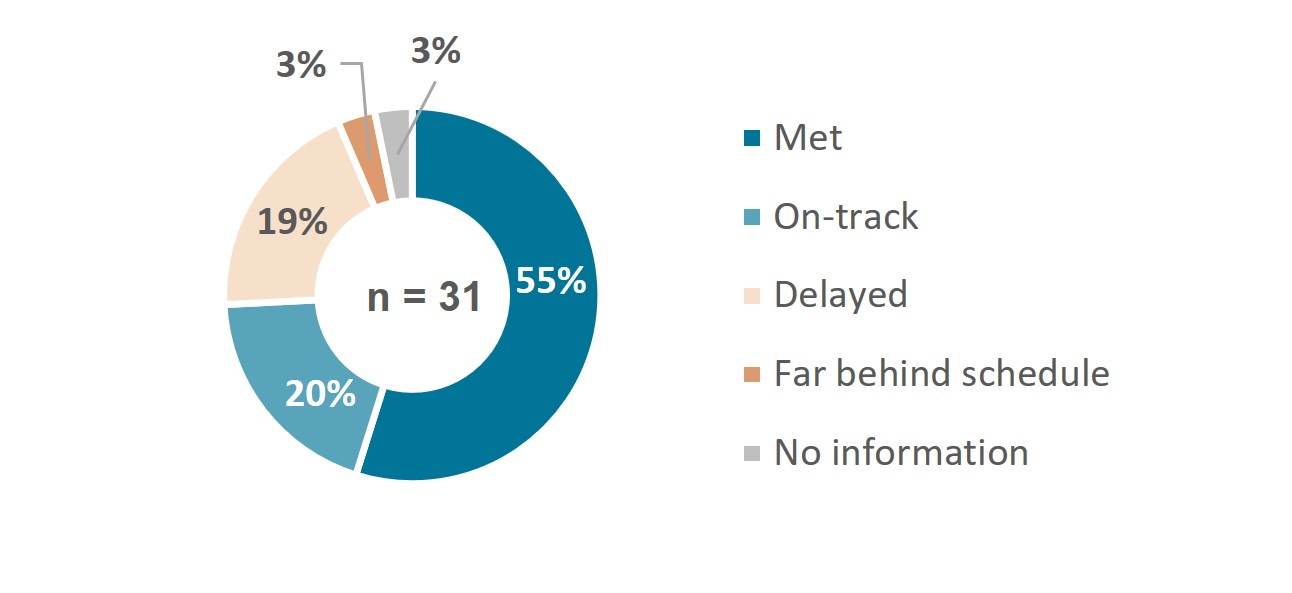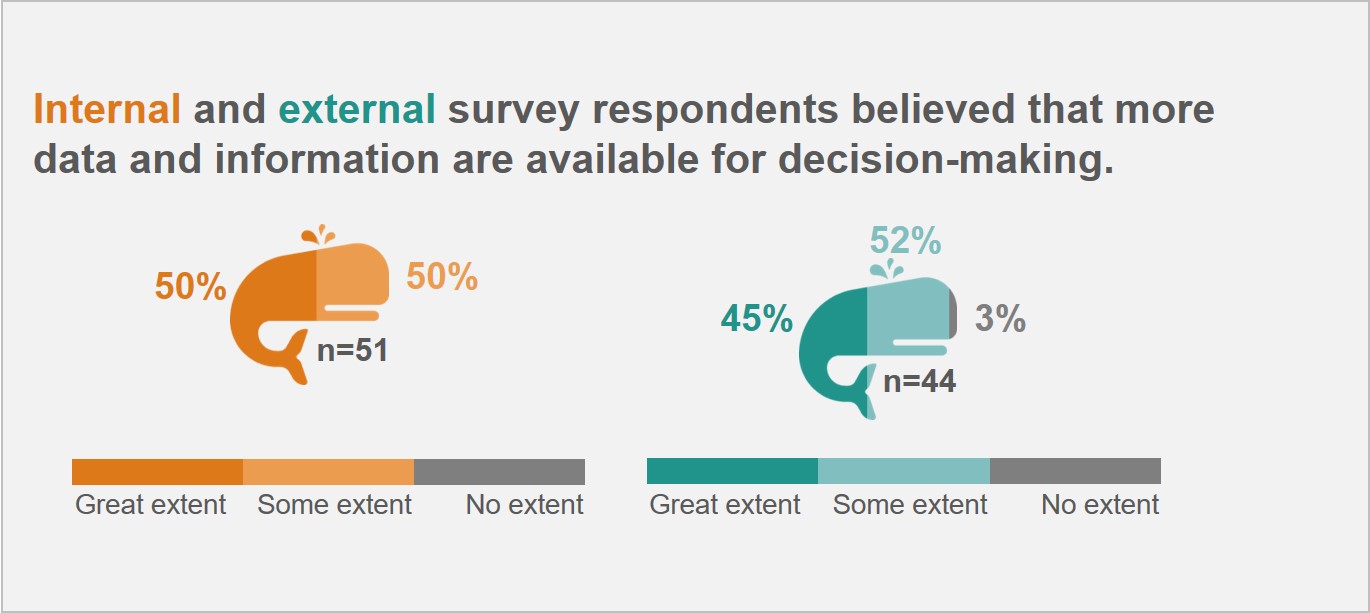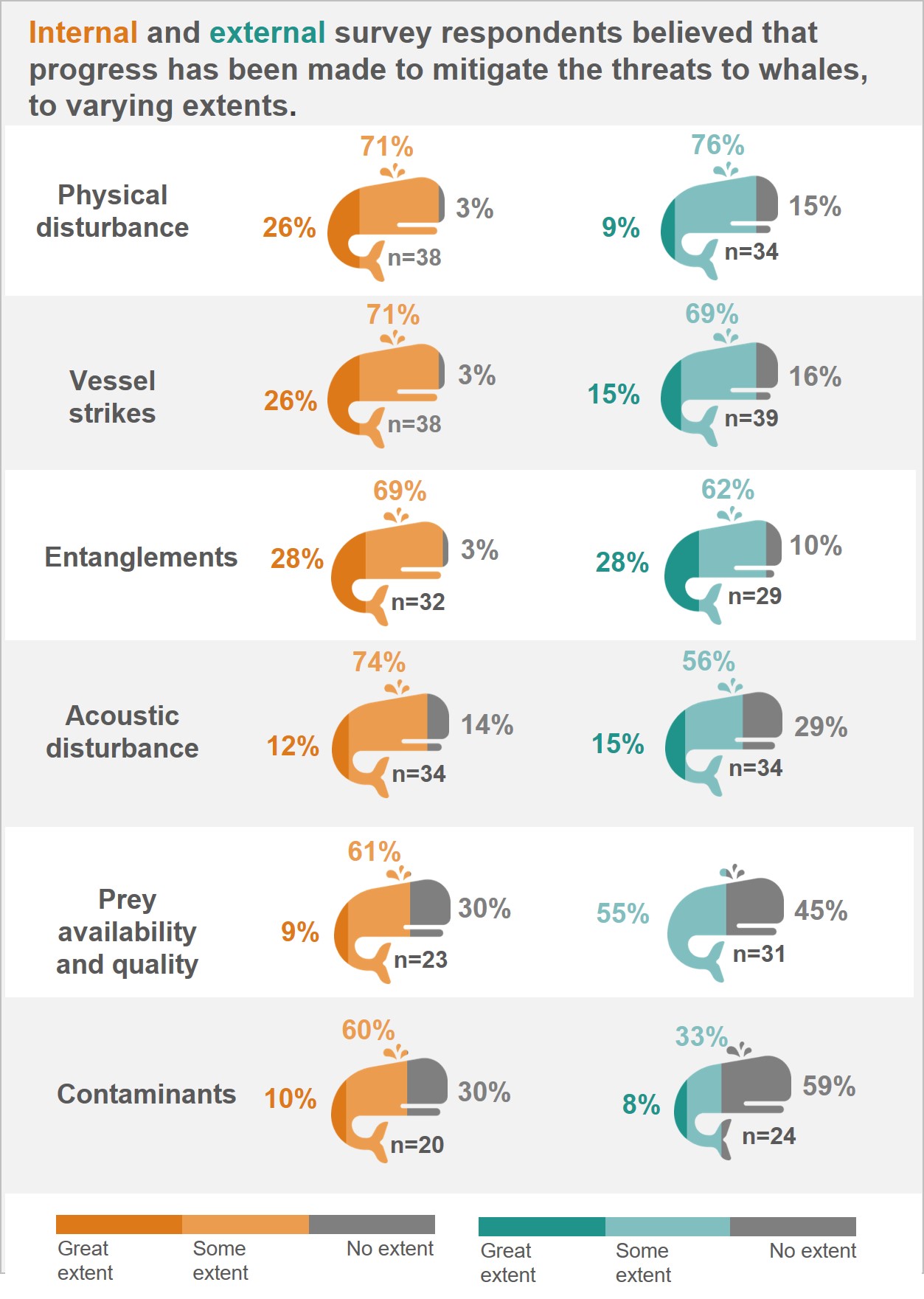Summary of the horizontal evaluation of funding dedicated to whales
Summary of the horizontal evaluation of funding dedicated to whales
(PDF, 319 KB)
Whale-related initiatives overview
Starting in 2017, the Government of Canada made investments to help protect and support the recovery of three endangered whale species: the North Atlantic right whale (NARW), the Southern Resident killer whale (SRKW), and the St. Lawrence Estuary beluga (SLEB).
Four partner departments and agencies (PDAs) were involved:
- Fisheries and Oceans Canada (DFO)/Canadian Coast Guard (CCG)
- Transport Canada (TC)
- Environment and Climate Change Canada (ECCC); and
- Parks Canada (PC)
Investments in whales were made through four key initiatives.
- Oceans Protection Plan (2017-18 to 2021-22)
- Whales Initiative (2018-19 to 2022-23)
- SRKW Initiative (2019-20 to 2023-24)
- Trans Mountain Expansion (2019-20 to 2021-22)
As part of the investments, the PDAs were responsible for implementing a number of activities that were intended to help mitigate threats that affect the survival and recovery of the endangered whale species.
The activities undertaken by DFO and CCG were intended to address the threats of disturbance (acoustic and physical), vessel strikes, and entanglements; prey availability and quality; and contaminants.
The activities undertaken by TC were intended to address the threats of disturbance (acoustic and physical), vessel strikes, and entanglements.
The activities undertaken by PC were intended to address the threats of disturbance (acoustic and physical), vessel strikes, and entanglements; prey availability and quality; and contaminants.
The activities undertaken by ECCC were intended to address the threats of contaminants.
About the evaluation
The evaluation was led by DFO’s Evaluation Division in collaboration with the three PDAs that have responsibilities for the delivery of whale protection and recovery measures. The evaluation was conducted between May and November 2022 and included an assessment of design and delivery, progress on addressing threats, and lessons learned for future programming for the time period from 2017-18 to 2021-22. It complied with the Treasury Board Policy on Results and responded to a requirement to conduct an evaluation of SRKW measures by March 2023.
Key findings
Whale-related activities were generally implemented, as planned.
- PDAs had the regulatory tools to effectively carry out their roles, although some gaps and challenges remain.
- Funded activities to support the protection and recovery of the targeted species were well-aligned with the programs, priorities, and mandates of PDAs; and with international guidelines and practices of other jurisdictions.
- PDAs faced some challenges during implementation, particularly with respect to COVID-19 and capacity, which affected the implementation of some planned activities.
- Measures and activities were planned using an adaptive strategy, which allowed for adjustments to activities based on sound advice, science, and Indigenous and stakeholder input.
Figure 1: Percentage of key implementation milestones that were met, on-track, or delayed.

Long description
This figure depicts a donut shaped infographic that indicates 55% of key implementation milestones were met, 20% were on track, 19% were delayed, 3% were far behind schedule and the status of another 3% were unknown due to a lack of information.
The three targeted whale species are significant to Indigenous Peoples’ cultures, communities, and the ecosystems on which they rely.
PDAs put processes in place to engage Indigenous communities and groups in whale-related programming; however, the level of satisfaction with those processes varied.
- Methods of engagement and consultation with the Indigenous communities and groups varied by year with evidence suggesting improvements were made based on feedback.
- The degree of involvement of Indigenous communities and groups in these processes varied.
- Several areas for improvement to the engagement and consultation processes were identified by Indigenous communities and groups.
The knowledge base to support decision-making related to whale protection and recovery has increased significantly as a result of new data collection, monitoring, Indigenous Knowledge and Science, and scientific research activities.
- Most targets for science products have been met or exceeded and a number of new reports and scientific publications on whales were made available.
- More information is now available on whale detection due to increased activities related to whale-related aerial surveillance and acoustic monitoring.
- Additional information is also now available on: whale behavioral data, vessel transit data, contaminant-sampling data, toxicological reports, photogrammetry datasets, and data tracking and visualization tools.

Long description
A visual depicts two whale shaped infographics that indicate that, of 51 internal survey respondents, half believed that more data and information was available to a great extent and the other half believed to some extent. Of 44 external respondents, 45% believed that more data and information was available to a great extent, 52% to some extent, and 3% to no extent.
There is room for improvement in terms of the accessibility, integration, and sharing of data to facilitate its use.
- Much of the information and science products that are now available as a result of whale-related monitoring and research activities are accessible on the websites of the PDAs.
- Finding, extracting, and using specific data was found to be challenging by stakeholders.
Critical data and information gaps remain.
- Research and monitoring work undertaken over the past five years does not address all existing and emerging information needs.
- Data and information gaps will always remain, and the process of addressing them is ongoing.

Long description
A visual depicts a whale shaped infographic that indicates that, of 32 external survey respondents, 97% said that there are critical remaining data or information gaps.
Progress has been made on mitigating threats to whales.
- There has been more significant progress in reducing entanglements and vessel strikes compared to progress addressing other threats (e.g., prey availability, acoustic disturbance, and contaminants), which typically require more time.
- However, there is more work to be done in areas such as compliance and enforcement, scope of activities, partnerships and engagement, and threat mitigation performance measurement.

Long description
A visual depicts twelve whale shaped infographics that indicate that, of 38 internal respondents, 26% believed that progress has been made to mitigate the threat of physical disturbance to a great extent, 71% to some extent, and 3% to no extent. By comparison, of 34 external respondents, 9% believed that progress has been made to mitigate the threat of physical disturbance to a great extent, 76% to some extent, and 15% to no extent.
For the threat of vessel strikes, of 38 internal respondents, 26% believed that progress has been made to mitigate this threat to a great extent, 71% to some extent, and 3% to no extent. By comparison, of 39 external respondents, 15% believed that progress has been made to mitigate the threat of vessel strikes to a great extent, 69% to some extent, and 16% to no extent.
Of 32 internal respondents, 28% believed that progress has been made to mitigate the threat of entanglement to a great extent, 69% to some extent, and 3% to no extent. Similarly, of 29 external respondents, 28% believed that progress has been made to mitigate the threat of entanglements to a great extent, 62% to some extent, and 10% to no extent.
For the threat of acoustic disturbances, of 34 internal respondents, 12% believed that progress has been made to mitigate this threat to a great extent, 74% to some extent, and 14% to no extent. By contrast, of 34 external respondents, 15% believed that progress has been made to mitigate the threat of acoustic disturbances to a great extent, 56% to some extent, and 29% to no extent.
Of 23 internal respondents, 9% believed that progress has been made to mitigate the threat of prey availability and quality to a great extent, 61% to some extent, and 30% to no extent. In comparison, of 31 external respondents, 55% believed that progress has been made to mitigate the threat of prey availability and quality to a great extent and 45% to some extent.
Lastly, for the threat of contaminants, of 20 internal respondents, 10% believed that progress has been made to mitigate this threat to a great extent, 60% to some extent, and 30% to no extent. By contrast, of 24 external respondents, 8% believed that progress has been made to mitigate the threat of contaminants to a great extent, 33% to some extent, and 59% to no extent.
Indigenous views on the effectiveness of recovery efforts were mixed.
- Indigenous communities and groups identified whale protection and recovery as a priority.
- Effectiveness of measures is unclear and the link between measures and benefits to the whales was questioned.
- All communities and groups believed continued or enhanced efforts are needed to recover and protect the target whale species.
A number of best practices were noted as playing an important role in ensuring the successful delivery of whale-related programming.
- These included the establishment of strong relationships with external partners, good working relationships between PDAs, and the adaptive strategy used for the implementation of whale-related activities.
- At the same time, several delivery challenges have been identified that could inform future whale-related programming. They are outlined below.
Considerations for future programming
While the findings from the evaluation did not result in any recommendations, the evaluation included areas that should be considered to help inform future programming decisions.
- Resources for Indigenous engagement: PC was the only PDA that had dedicated efforts and resources to facilitate engagement with First Nations, which resulted in improved relationships and collaboration on monitoring projects. There is continued interest from Indigenous communities and groups to be involved in whale-related protection activities; however, a lack of funding to participate in engagement activities has reduced their capacity and willingness.
- Funding: There was a lack of resources for some activities, such as enforcement, marine mammal response, and SLEB. In addition, the time-limited funding made it difficult to plan long-term, including for staffing and to demonstrate long-term commitment to whale protection.
- Governance and coordination: The lack of funding for a secretariat function and other internal services had an impact on the ability of DFO to coordinate with other PDAs and to report on implementation progress at the national level.
- Data sharing: Although there has been an increase in new whale-related data and information, data storage, sharing, and accessibility was found to be challenging for some stakeholders, which impacted the usefulness of data and information.
- Performance measurement: A lack of appropriate performance indicators to assess the effectiveness of measures and mitigation of threats made it difficult to fully measure progress and appropriateness. Better data management practices and performance indicators would facilitate that, now that PDAs have built baseline knowledge of whale protection.
- Regulatory complexities: In addition to legislation/regulatory amendments taking time, the cross-jurisdictional nature of the activities made it hard to manage certain legislative tools, especially on the Atlantic Coast. This has an impact on the implementation of measures, as well as on their enforceability.
- Date modified: